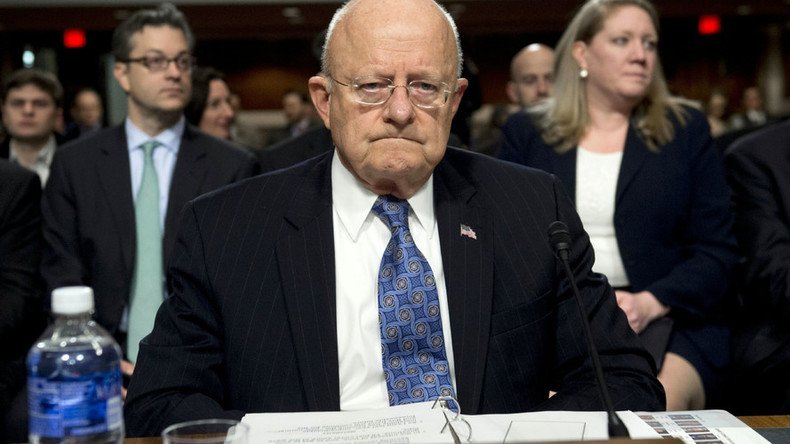‘Homegrown Sunnis’, Russia & China top intel chiefs’ list of 2016 threats

Global climate change, homegrown terrorists, encrypted messaging and the increasingly assertive Russia and China topped the list of threats to US interests, as defined by the country’s intelligence community chiefs who testified before the Senate.
Appearing before the Senate Armed Services Committee, the US Director of National Intelligence (DNI) James Clapper and director of the Defense Intelligence Agency (DIA), Lt. General Vincent Stewart, painted a picture of the world fraught with peril for US interests.
The bulk of their assessment differed little from last year’s gloomy outlook, touching on the “usual suspects” such as Russia, China, Iran and North Korea, as well as Islamic extremist groups. In what he termed a “litany of doom,” Clapper also touched upon refugees, climate change, cyber security and oil prices.
Top US intel official Clapper calls his own testimony to Senate Armed Services a "litany of doom." #litanyofdoom
— Bill Roberts (@BillRoberts3) February 9, 2016
DNI Clapper on overall threat picture, global order: “It’s certainly the most diverse array of threats and challenges that I can recall.”
— Office of the DNI (@ODNIgov) February 9, 2016
ISIS and homegrown sympathizers
“Sunni violent extremism has been on an upward trajectory since the late 1970s and has more groups, members, and safe havens than at any other point in history,” Clapper said.
While the so-called Islamic State (IS, formerly ISIS/ISIL) is being pushed back in Iraq and Syria, it is spreading into Libya and elsewhere in Africa and continues to recruit and inspire followers in Europe and the US.
There were five times as many arrests of suspected IS followers inside the US in 2015 than in 2014, Clapper noted. IS will “probably attempt to conduct additional attacks in Europe, and attempt to direct attacks on the US homeland in 2016,” using “homegrown” sympathizers, Clapper added, citing the examples of the 2015 attacks in Chattanooga and San Bernardino.
Echoing a talking point frequently brought up by US intelligence and law enforcement officials, the DNI warned that terrorists “will easily take advantage of widely available, free encryption technology, mobile-messaging applications, the dark web, and virtual environments to pursue their objectives.”
Clapper: Violent extremists increased use of encrypted & secure Internet- & mobile-based technologies enables terrorist actors to "go dark"
— Office of the DNI (@ODNIgov) February 9, 2016
In Afghanistan, the US-backed government is in danger of a “political breakdown” as Taliban grows stronger. The intelligence community predicts “fighting in 2016 will be more intense than 2015, continuing a decade-long trend of deteriorating security.”
Despite nearly 15 years of being targeted by the US, Al-Qaeda and its affiliates have “proven resilient and are positioned to make gains in 2016,” Clapper said, citing the examples in Syria and Yemen.
Dealing with Iran
While Clapper maintained that Iran was a “continuing terrorist threat to US interests and partners worldwide,” he defended the nuclear deal reached with Tehran last July.
Pressed by lawmakers to label Iran’s missile tests as a violation of the agreement, Clapper called them a “deliberate message of defiance” but noted that the nuclear deal said nothing about missile testing or development.
DNI Clapper: “We in the U.S. intelligence community are in the ‘distrust and verify’ mode” on Iran deal in response to Sen. Blumenthal.
— Office of the DNI (@ODNIgov) February 9, 2016
Iran was also mentioned in the context of Syria, where Iranian advisers and the Tehran-backed Hezbollah militia were helping the government in Damascus fight the US-backed rebels as well as Islamic State.
How do you solve a problem like Syria?
Addressing the Syrian refugee crisis, Clapper noted that there were approximately 60 million refugees and displaced persons worldwide, and that the problem will only become worse with time due to climate change and “weather aberration events.”
As for the offer by Saudi Arabia and the United Arab Emirates to send ground troops into Syria, they would have to rely on US command and control, or even be accompanied by US forces.
“I do not assess that Saudi ground forces would have the capacity to take this on,” said Stewart.
Russia’s intervention in Syria has “changed the calculus completely,” additionally bolstering the government, noted General Stewart.
However, both he and Clapper appeared convinced that Russian and Iranian interests will eventually diverge, with Iranians more interested than Moscow in backing President Bashar al-Assad personally.
“I think Russians are not wedded to Assad personally,” Clapper speculated. “But they have the same challenge as others: If not Assad, who?”
Traditionally threatened by Russia
Clapper and Stewart also argued that Russia represented a threat to the US in every sphere, from the Arctic to Ukraine and from the Earth orbit to cyberspace – while also maintaining that the Russian economy was suffering under Western sanctions and plummeting oil prices.
DNI Clapper: Putin is the first leader since Stalin to expand Russia’s territory. pic.twitter.com/qxOgZa2C86
— Office of the DNI (@ODNIgov) February 9, 2016
The low price of oil is working to US advantage, Clapper argued, noting that it has hampered Russian military modernization and energy projects in the Arctic, while bringing Venezuela to the brink of bankruptcy.
However, he also noted that the US-backed government in Baghdad and the Kurdish regional authority in Erbil were having difficulties making ends meet because of declining oil revenues.
Asked by several lawmakers if the Russian economic crisis could result in street demonstrations, Clapper was carefully noncommittal. He also admitted he did not know how much of Russia’s budget came from oil revenues, saying only he believed it was “a significant proportion.”
“Russians have a great capacity for enduring pain and suffering,” Clapper said.












